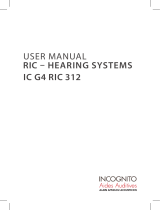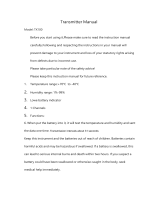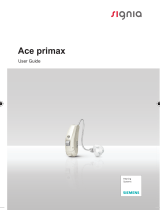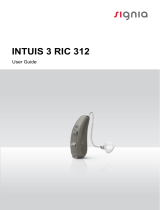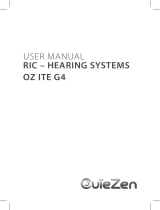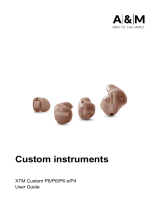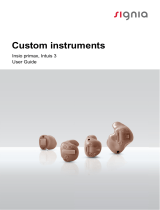Page is loading ...

Life sounds brilliant.
www.siemens.com/hearing
Pure micon
User Guide

2 Content
Content
Welcome 4
Your hearing instruments 5
Getting to know your hearing instruments 5
Components and names 6
Controls 7
Settings 10
Battery size and ear pieces 11
Service information 12
Batteries 13
Replacing non-rechargeable batteries 13
Recharging rechargeable batteries 14
Daily use 15
Turning on and off 15
Inserting 17
Removing 19
Adjusting the volume 20
Changing the hearing program 21
Further adjustments (optional) 22
Using two hearing instruments 22
On the phone 23
Telephone program 23
Automatic program switch (AutoPhone) 23

3Content
Audio induction loops 26
Telecoil program and remote control 26
Maintenance and care 27
Cleaning 27
Drying 28
Storage 28
Exchanging ear pieces 28
Troubleshooting 30
Important information 31
Intended use 31
Explanation of symbols 31
Transport and storage conditions 31
Disposal information 32
Technical information 32
Conformance information 34
Important safety information 35
Personal safety 35
Product safety 37
Country-specic information 39

Welcome4
You have chosen a Siemens hearing instrument, a reliable
partner to accompany you through everyday life. Like
everything new, it will take you a little while to become
familiar with it.
This document, along with support from your Hearing
Care Professional, will help you. You will quickly come to
appreciate the advantages and greater quality of life your
hearing instrument offers.
CAUTION
Read this user guide thoroughly and completely
and follow the safety information in this document
to avoid damage or injury.
To benet most from your hearing instrument, wear it
daily and all day long. Especially after longer periods of
living with hearing loss, a dedicated hearing training is
recommended - with a Hearing Care Professional or at
home.
Welcome

Your hearing instruments 5
Getting to know your hearing instruments
It is recommended to familiarize yourself with your new
hearing instruments. With the instruments in your hand
try using the controls and note their location on the
instrument. This will make it easier for you to feel and
press the controls while wearing the hearing instruments.
NOTICE
uDo not pull the receiver connec-
tion as this could damage your
hearing instruments.
If you have problems pressing the controls of your
hearing instruments while wearing them, you can
ask your Hearing Care Professional about a remote
control option.
Your hearing instruments

Your hearing instruments6
Components and names
ૢ
ૢ
ૠ
➊ Ear piece
➋ Receiver
➌ Receiver cable
➍ Microphone openings
➎ Rocker switch (standard),
push button or no control
(optional)
➏ Charging contacts
(optional)
➐ Battery compartment
➑ Side indicator
(red = right ear,
blue = left ear)
➒ Receiver connection

Your hearing instruments 7
Controls
With the controls you can, for example, adjust the volume
or switch hearing programs. Your hearing instruments
either have a push button or a rocker switch – or no
control at all.
The Hearing Care Professional has assigned your desired
functions to the controls.
Ask your Hearing Care Professional to mark your
controls and their functions on the following
pages.
Control Left Right
Push button
Rocker switch
No control
You can also use a remote control.

Your hearing instruments8
Push button
Function Left Right
Program change
Volume up
Volume down
Standby/turn on
press briefly,
press 2 seconds

Your hearing instruments 9
Rocker switch
Function Left Right
Program up/down
Volume up/down
Tinnitus noiser
level up/down
Sound balance
Standby/turn on
press briefly,
press 2 seconds,
press 5 seconds

Your hearing instruments10
Settings
Ask your Hearing Care Professional to mark your
individual settings on the following pages.
Hearing programs
1
2
3
4
5
6
Read more in section "Changing the hearing program".
Features
Power-on delay enables whistle-free insertion of
hearing instruments.
Read more in section "Turning on and off".
e2e wireless enables simultaneous control of both
hearing instruments.
Read more in section "Using two hearing instru-
ments".
AutoPhone automatically switches to the telephone
program when the telephone receiver approaches
the ear.
Read more in section "On the phone".

Your hearing instruments 11
Accessories
Remote control Audio streamer
Charger
Battery size and ear pieces
Batteries
Non-rechargeable (size 312)
Rechargeable (size 312)
Exchangeable ear pieces Size
Click Dome single
(open or closed)
Click Dome semi-open
Click Dome double
Custom shell
Click Mold

Your hearing instruments12
Service information
Serial numbers
Left:
Right:
Service dates
1:
2:
3:
4:
5:
6:
Your Hearing Care Professional
Date of purchase:

Batteries 13
When the battery is low the sound becomes weaker or
you will hear an alert signal. It depends on the battery
type how long you have until you have to replace or
recharge the battery.
Replacing non-rechargeable batteries
Remove empty batteries immediately and dispose of
according to local regulations.
Remember to have your replacement batteries
with you at all times.
Removing:
uOpen the battery compartment.
The battery falls out when the compart-
ment is completely open.
uIf the battery does not fall out, lightly
tap the instrument or use the magnet
stick. The magnet stick is available as an
accessory.
Batteries

Batteries14
Inserting:
uRemove the protective lm from the new bat-
tery.
uInsert the battery with the "+" symbol
facing up (refer to the picture).
uCarefully close the battery compartment. If you feel
resistance, the battery is not inserted correctly.
Do not attempt to close the battery compartment by
force. It can be damaged.
Recharging rechargeable batteries
Charge rechargeable batteries before rst use.
uTo charge the batteries, follow the instructions in the
charger’s user guide.
After many recharging cycles, the battery lifetime may
reduce. In this case, replace the rechargeable battery with
a new one. To do so, follow the instructions for replacing
non-rechargeable batteries.

Daily use 15
Turning on and off
You have several options to turn your hearing instru-
ments on or off.
Via battery compartment:
uTurning on: Close the battery compartment.
The default volume and hearing program are set.
uTurning off: Open the battery compartment.
After charging:
uTurning on: Take the instruments out of the charger.
The previously used volume and hearing program are
set.
Via push button or rocker switch:
uTurning on or off: Press the push button or the
rocker switch. Refer to section "Controls" for your per-
sonal settings.
After turning on, the previously used volume and
hearing program are set.
Daily use

Daily use16
Via remote control:
uFollow the instructions in the remote control's user
guide.
After turning on, the previously used volume and
hearing program are set.
■ When wearing the hearing instruments, an
optional signal can indicate when an instrument
is turned on or off.
■ Remove the batteries if the hearing instruments
are not used for several days.
When the power-on delay is activated, the hearing
instruments turn on after a delay of several seconds.
During this time you can insert the hearing instruments
without experiencing unpleasant whistling.
The "power-on delay" can be activated by your Hearing
Care Professional.

Daily use 17
Inserting
Your hearing instruments have been ne-tuned for your
right and left ear. Colored markers indicate
the side:
■ red marker = right ear
■ blue marker = left ear
To insert the hearing instrument:
uHold the receiver cable at the bend.
uCarefully push the ear piece in
the ear canal.
uTwist it slightly until it sits well.
Open and close your mouth to
avoid accumulation of air in the
ear canal.
uLift the hearing instrument and
slide it over the top of your ear.
CAUTION
Risk of injury!
uInsert the ear piece carefully and not too deeply
into the ear.

Daily use18
■ Insert the right hearing instrument with the
right hand and the left hearing instrument with
the left hand.
■ If you have problems inserting the ear piece,
use the other hand to gently pull your earlobe
downwards. This opens the ear canal and eases
insertion of the ear piece.
The optional concha lock helps to securely retain the
ear piece in your ear. To position the concha lock:
uBend the concha lock and position it
carefully into the bowl of your ear (refer
to the picture).

Daily use 19
Removing
uLift the hearing instrument and
slide it over the top of your ear.
uIf your hearing instrument is
equipped with a custom shell or
a Click Mold, remove it by pulling
the small removal cord toward
the back of your head.
uFor all other ear pieces: Grip the receiver in the
ear canal with two ngers and pull it carefully out.
CAUTION
Risk of injury!
uIn very rare cases the ear piece could remain in
your ear when removing the hearing instru-
ment. If this happens, have the ear piece
removed by a medical professional.
Clean and dry your hearing instruments after usage. Read
more in section "Maintenance and care".

Daily use20
Adjusting the volume
Your hearing instruments automatically adjust the volume
to the listening situation.
uIf you prefer manual volume adjustment, press the
push button or the rocker switch, or use a remote con-
trol.
Refer to section "Controls" for your personal settings.
An optional signal can indicate the volume change.
/

